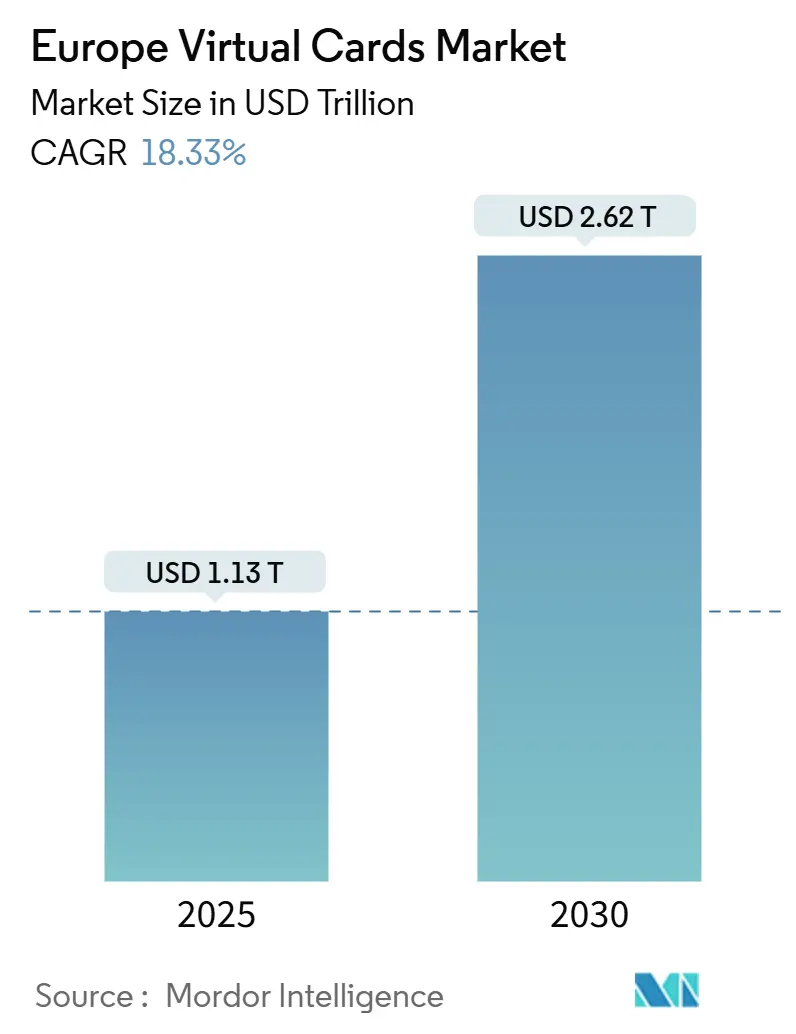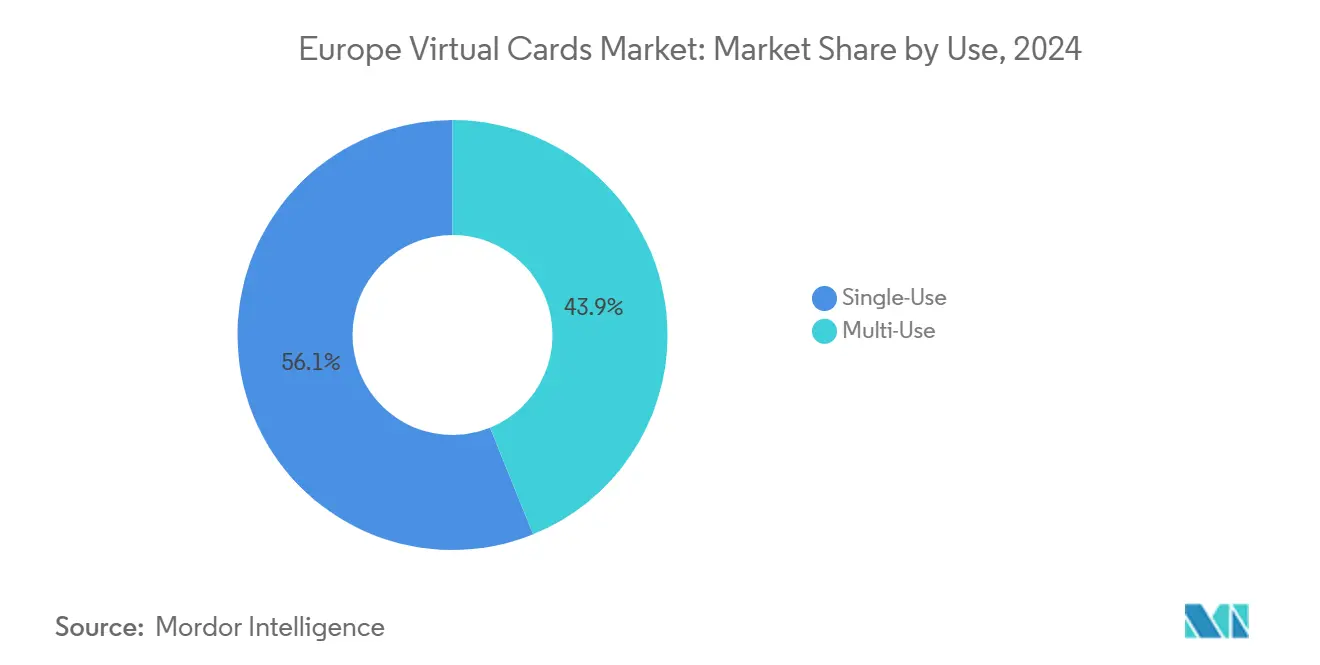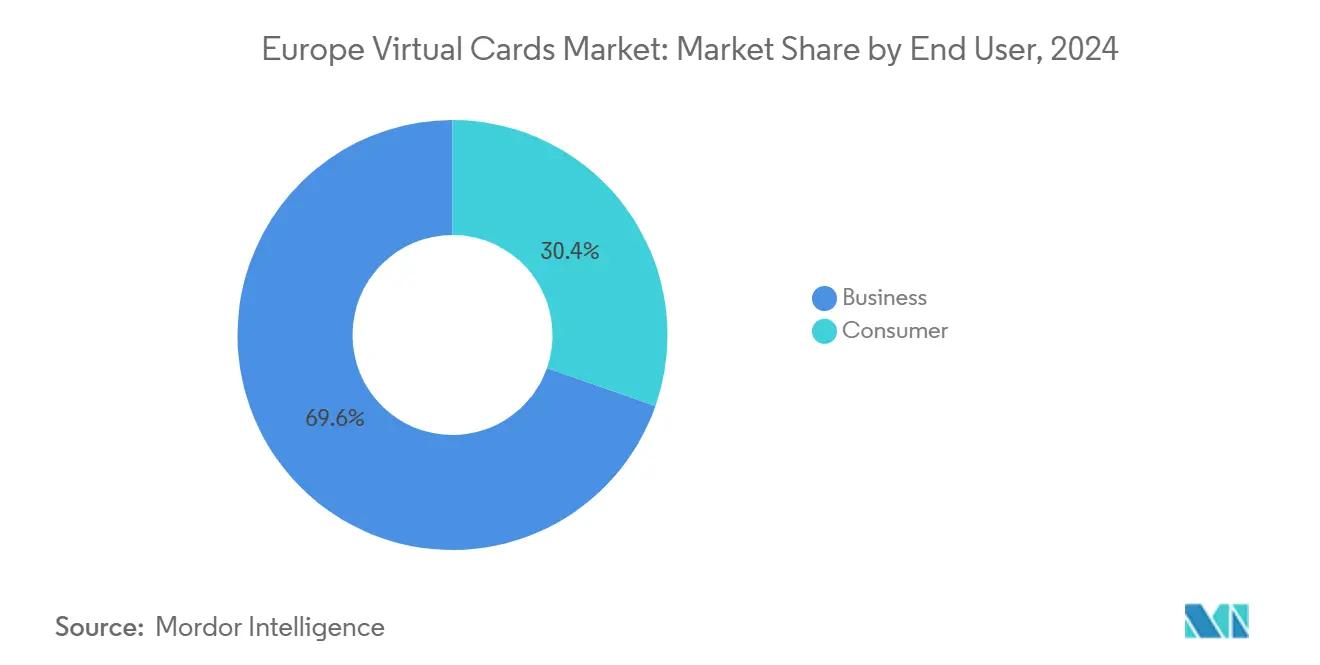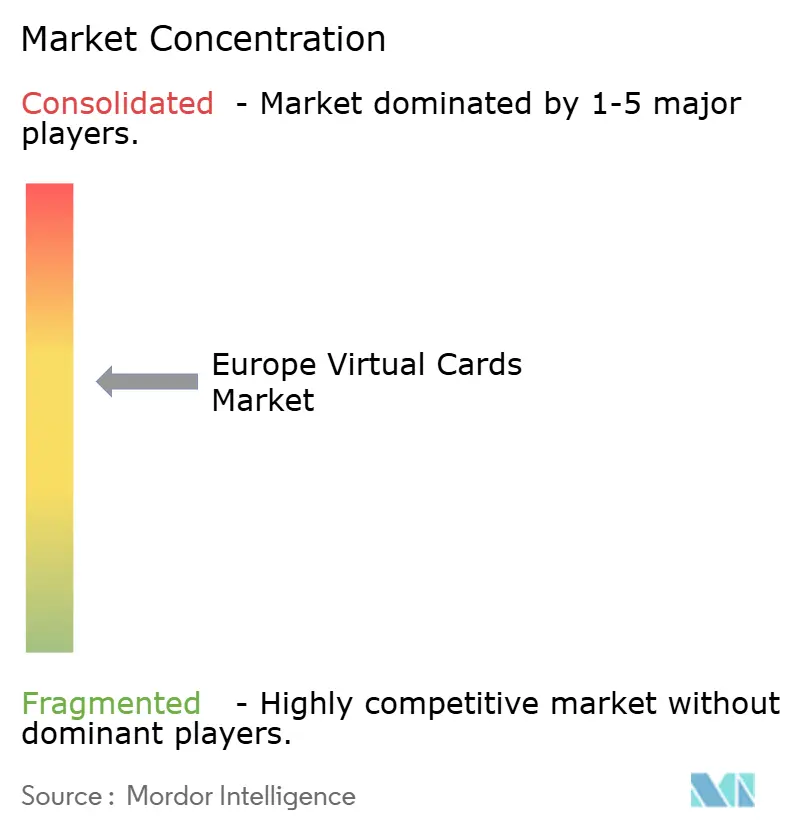
Europe Virtual Cards Market Analysis by Mordor Intelligence
The European virtual cards market reached a value of USD 1.13 trillion in 2025 and is on course to hit USD 2.62 trillion by 2030, reflecting an impressive 18.33% CAGR through the forecast horizon. Payments digitalization, regulatory initiatives such as PSD2 and the coming PSD3 package, and rising corporate appetite for process automation continue to expand addressable use cases. Embedded-finance platforms now wrap virtual card issuance into workflow software, allowing businesses to digitize payables without new banking relationships. Meanwhile, consumer familiarity with contactless tap-and-go flows has lifted expectations for friction-free experiences in every channel, pushing issuers to converge remote and point-of-sale (POS) capabilities. Competitive intensity is accelerating as traditional banks, global schemes, and fintech specialists race to combine tokenization, single-use credentials, and AI-driven fraud analytics. Compliance costs, particularly for cyber-risk cover and interchange caps, squeeze smaller issuers’ margins but also invite fee-based value-added services—treasury dashboards, dynamic spend rules, and real-time reporting—to defend profitability.
Key Report Takeaways
- By transaction channel, remote payments captured 78.95% of the European virtual cards market share in 2024, while the POS segment is forecasted to advance at a 29.86% CAGR to 2030.
- By use pattern, single-use virtual cards held 56.13% of the European virtual cards market share in 2024 and are on track for a 21.17% CAGR through 2030.
- By end user, the business segment commanded 69.64% of the European virtual cards market size in 2024 and is projected to compound at 22.53% annually to 2030.
- By card type, virtual credit cards led with a 46.79% share of the European virtual cards market in 2024; virtual prepaid cards are projected to be the fastest-growing category, expanding at a 22.26% CAGR.
- By country, the United Kingdom accounted for 21.23% of the European virtual cards market share in 2024, whereas Spain shows the steepest growth trajectory at 20.41% CAGR to 2030.
Europe Virtual Cards Market Trends and Insights
Drivers Impact Analysis
| Driver | (~) % Impact on CAGR Forecast | Geographic Relevance | Impact Timeline |
|---|---|---|---|
| Surging B2B demand for automated accounts payable settlement | +4.2% | Global, strongest in the UK & Germany | Medium term (2-4 years) |
| E-commerce & contactless boom post-COVID-19 | +3.8% | Global, led by Nordics & Netherlands | Short term (≤ 2 years) |
| PSD2/SCA compliance elevates security preference for tokenized cards | +2.9% | EU-wide, mandatory compliance | Long term (≥ 4 years) |
| Embedded-finance APIs slash SME onboarding frictions | +2.1% | Western Europe, expanding eastward | Medium term (2-4 years) |
| Digitization of meal-voucher benefits across continental Europe | +1.7% | France, Belgium, and Germany core markets | Medium term (2-4 years) |
| Travel intermediaries' pivot to single-use VCNs for supplier credit | +1.4% | Tourism-heavy economies: Spain, Italy, France | Short term (≤ 2 years) |
| Source: Mordor Intelligence | |||
Surging B2B Demand for Automated Accounts-Payable Settlement
Eight in ten European B2B transactions are expected to be digital by 2025, turning virtual cards into a core treasury tool for supplier payments. American Express indicates that businesses deploying single-use credentials report material drops in manual reconciliation costs, while fleet and mobility programs achieve 19% penetration because dynamic spend limits deliver granular control[1]American Express Co., “Corporate Payments Outlook 2025,” americanexpress.com. Mid-market firms, previously priced out of sophisticated cash-management technology, now gain those capabilities through cloud platforms that embed issuance APIs. This democratizes working-capital optimization and cements virtual cards as the default B2B instrument across a widening range of sectors.
E-commerce & Contactless Boom Post-COVID-19
Contactless transactions significantly increased in H1 2024 and now account for the majority of non-remote card payments in the euro area. Mastercard plans to phase out manual card entry for European e-commerce by 2030 via network-level tokenization, signaling a deep commitment to friction elimination. Digital wallets account for around 30% of online spend and still rely on cards for two-thirds of their funding, creating reinforcing network effects that keep card rails central even as wallet brands proliferate. The rising interchange between online and offline settings benefits issuers able to offer a single virtual credential that authenticates flawlessly whether tapped on a terminal or provisioned inside a browser checkout.
PSD2/SCA Compliance Elevates Security Preference for Tokenized Cards
More than 30% of Mastercard European volumes are now tokenized, yielding higher approval rates and lower fraud incidence compared with PAN-based transactions. Strong Customer Authentication (SCA) has effectively repositioned security from a cost center to a competitive lever; issuers with fully tokenized portfolios enjoy preferential risk scoring by acquirers. Virtual cards naturally fulfil SCA because each credential can be limited by value, merchant category, and expiration, making them attractive to corporates managing cross-border supplier payments. The forthcoming PSD3 text is expected to tighten supervisory oversight and incentivize broader token adoption, extending the driver’s positive effect well into the next decade.
Embedded-Finance APIs Slash SME Onboarding Frictions
Card networks now expose low-code modules that let software platforms issue Virtual Card Numbers (VCNs) at the moment of need, embedded directly into procurement or travel workflow solutions. Mastercard’s VCN toolkit has been integrated by corporate travel platforms such as HRS, cutting implementation time for new clients and widening reach into the long-tail SME segment. By bundling instant credit lines and transaction-level controls, embedded offers tackle the EUR 400 billion funding gap confronting European SMEs; fintech lender Finmid recorded a 39% lift in gross merchandise value once embedded finance went live for its platform partners. The result is a self-reinforcing upgrade cycle where SMEs adopt virtual cards as part of broader workflow digitization.
Restraints Impact Analysis
| Restraint | (~) % Impact on CAGR Forecast | Geographic Relevance | Impact Timeline |
|---|---|---|---|
| Low digital adoption among senior citizens | -2.3% | Rural areas across the EU, strongest in Southern Europe | Long term (≥ 4 years) |
| Interchange & surcharge regulation compresses issuer margins | -1.8% | EU-wide regulatory framework | Medium term (2-4 years) |
| Fragmented BIN-sponsorship rules hinder cross-border issuance | -1.2% | Cross-border operations, particularly in Eastern Europe | Medium term (2-4 years) |
| Rising cyber-insurance premiums for fintech issuers | -0.9% | Fintech-heavy markets: UK, Germany, Netherlands | Short term (≤ 2 years) |
| Source: Mordor Intelligence | |||
Low Digital Adoption Among Senior Citizens
Roughly 40 million euro-area residents still lack a payment card, and cash remains the preferred method for 52% of in-store transactions. The demographic tilt is stark: consumers aged 65 and older demonstrate the lowest uptake of mobile payments, citing trust and privacy concerns. Rural pockets across Italy, Greece, and Portugal accentuate the divide, where limited broadband access further dampens digital adoption. These patterns cap penetration ceilings for virtual cards in certain spend categories, compelling issuers to maintain hybrid acceptance infrastructures that support cash-on-delivery or giro transfers alongside digital rails while targeted literacy initiatives attempt to narrow the gap.
Interchange & Surcharge Regulation Compress Issuer Margins
Visa and Mastercard extended the EU interchange cap regime beyond 2024, freezing revenue that issuers traditionally reinvested in rewards and fraud systems[2]Visa Inc., “European Interchange Compliance Update,” visa.com. Upcoming Payment Services Regulation proposals seek even greater transparency on cross-border fees and currency conversion spreads. Smaller fintech issuers without diversified income streams face margin compression, potentially slowing their ability to subsidize virtual card incentives. Nonetheless, larger banks leverage scale to pivot toward fee-based treasury services, while networks promote value-added tokenization and fraud-prevention modules priced outside the regulated interchange construct.
Segment Analysis
By Use: Security-First Momentum for Single-Use Credentials
Single-use virtual cards controlled 56.13% of the European virtual cards market share in 2024 and are projected to expand at a 21.17% CAGR. Within the European virtual cards market for B2B travel procurement, single-use limits safeguard against supplier default by tying each payment to a discrete booking reference, eliminating downstream reconciliation errors. Fleet programs mirror this logic, preferring one-time numbers for fuel transactions that cannot be cloned at the pump.
Enterprises increasingly embed policy logic—such as automatic expiry upon invoice matching—within every new credential. This embedded control appeals to audit teams as regulation tightens around supply-chain transparency. Meanwhile, multi-use cards survive in subscription software and advertising spend, where predictability outweighs elevated fraud risk. Even here, issuers inject controls, capping cumulative spend or pre-authorizing merchants. Together, these trends keep security-centered functionality at the fore of Europe's card market growth trajectories.

By Payment Type: Remote Dominance Meets POS Acceleration
Remote channels held 78.95% of the European virtual cards market share in 2024, but POS usage is expected to surge at 29.86% CAGR over the forecast period, signaling channel convergence. The European Central Bank notes that tap-and-go card usage nearly quadrupled between 2019 and 2024, and mobile wallets increasingly provision virtual credentials that emulate contactless plastic.
Mastercard’s 2025 launch of a mobile VCN app gives corporates the ability to push commercial cards into Apple Pay and Google Wallet in seconds, enabling the same token to operate across e-commerce, in-app, and in-store flows. This omnichannel capability raises authorization rates because the credential carries rich metadata—device ID, geolocation, merchant ID—shielding issuers from chargeback risk. As retailers upgrade terminals to NFC phones, point-of-sale virtual card acceptance barriers fade, allowing the European virtual cards market to capture in-store spend once reserved for traditional plastic.
By End User: Corporate Spend Drives Out-sized Growth
Businesses accounted for 69.64% of the European virtual cards market share in 2024 and are set to compound at 22.53% annually over the forecast period. Corporate treasurers gravitate toward virtual cards for automated expense reconciliation. Insurance major AXA now disburses health-care claims via instant virtual credit, delivering funds within seconds to providers and trimming administrative lag.
SME platforms extend the rationale: accounting software embeds issuance, so invoices auto-convert into single-use numbers at approval. These built-in controls lower fraud and boost cash-flow forecasting accuracy, reinforcing adoption. Consumer uptake lags owing to limited merchant education; however, Gen-Z segments show high receptivity when cards are presented in digital-wallet form factors, foreshadowing broader adoption over time across the European virtual cards industry.

By Card Type: Credit Leads, Prepaid Accelerates
Virtual credit cards constituted 46.79% of the European virtual cards market share in 2024, benefiting from deferred-payment terms and long-standing corporate credit lines. Conversely, prepaid instruments are projected to grow at 22.26% CAGR by meeting regulated use cases—meal vouchers, mobility benefits, and gig-economy payouts—where employers require strict spend categorization. Edenred reports that 100% of new employee-benefit contracts delivered in H1 2024 were digital, highlighting the prepaid momentum.
Debit-based virtual cards occupy a middle ground, serving B2B marketplaces wanting instant settlement without credit exposure. Ultimately, issuers differentiate less by funding source and more by control layers: spend caps, token-level controls, and real-time program analytics. These features underpin loyalty while compliance pressures—money-laundering checks, VAT reporting—push corporates toward the data-rich environment of virtualized credentials, keeping card-type diversification a core pillar of Europe's Cards market evolution.
Geography Analysis
The United Kingdom’s 21.23% share in the European virtual cards market in 2024 positions it as the epicenter of virtual-card innovation in Europe. Open-banking legislation accelerated API connectivity, and fintech champions such as Revolut distribute instant VCNs that spin up and down via app interfaces, reinforcing consumer expectations for real-time control. London’s status as a global treasury hub further magnifies B2B demand, as multinationals center payable operations in sterling accounts before issuing EUR- or USD-denominated virtual cards to suppliers.
Germany and France together form the largest addressable commercial card pool. Germany’s export-oriented manufacturing sector relies on supplier pre-payments, a natural fit for single-use cards that improve working-capital visibility, while France benefits from Edenred’s continued digitization of meal vouchers, which generated EUR 774 million in European operating revenue in H1 2024. Interchange regulations apply equally across both markets, yet merchants accept marginally higher commercial card fees because automated reconciliation reduces back-office costs.
Spain is projected to exhibit the fastest CAGR at 20.41% over the forecast period. The tourism rebound elevates hotel and airline reconciliation complexity, propelling online travel agencies toward single-use VCN adoption. Spanish SMEs also tap EU recovery funds earmarked for digitization, channeling investments into software that includes embedded virtual-card modules. Southern European consumer preference for contactless payments surged during the pandemic, laying behavioral foundations for virtual-card wallet uptake.
Nordic and Benelux economies display near-cashless states, with instant account-to-account schemes like iDEAL and Vipps forming the baseline rail. Rather than cannibalizing card volumes, these rails complement the European virtual cards market by encouraging merchants to invest in API-driven acceptance infrastructure, thereby shrinking marginal costs for adding virtual card acceptance. Eastern Europe represents a leapfrog opportunity: limited incumbent card penetration allows issuers to seed markets directly with mobile-only virtual products, bypassing physical plastic and accelerating scale once regulatory frameworks align.
Competitive Landscape
The European virtual cards market exhibits moderate fragmentation. Global schemes Visa and Mastercard anchor network economics, but issuing power disperses across large banks—HSBC, Barclays—fintech disrupters such as Revolut and Klarna, and specialized processors like Marqeta and Stripe. PSD3 and the European Payments Initiative’s Wero wallet aim to lower barriers for alternative rails, forcing incumbents to double down on differentiated fraud tooling and value-added services.
Traditional players pursue scale: SEB Group acquired AirPlus for EUR 450 million in 2024 to expand corporate-card reach across 20 countries, adding 60,000 client contracts and 1.4 million active cards[3]SEB Group, “Completion of AirPlus Acquisition,” sebgroup.com. Fintech challengers compete on user experience and speed; Finmid’s embedded-credit APIs enable B2B platforms to generate virtual cards inside a merchant dashboard, onboarding SMEs in under 24 hours while offloading credit risk to banking partners.
Technology is the battleground. Issuers invest in AI-driven fraud engines that analyze token context in milliseconds, pushing approval rates above 98%. Networks roll out Edge compute nodes to localize token vaults, trimming latency and meeting data-sovereignty rules. White-space remains in niche verticals—health-care payout automation, gig-economy wallet services, and ESG-linked supplier cards that redirect interchange rebates toward carbon-offset projects. Players able to tailor credentials for sector-specific compliance win a disproportionate share as the market scales.
Europe Virtual Cards Industry Leaders
-
Mastercard
-
Visa
-
Marqeta
-
Stripe
-
WEX
- *Disclaimer: Major Players sorted in no particular order

Recent Industry Developments
- May 2025: Revolut confirmed its integration with the European Payments Initiative’s Wero instant-payment scheme to offer in-app P2P transfers across Germany, Belgium, and France.
- April 2025: Mastercard activated its embedded Virtual Card Number program for partner banks, enabling instant VCN issuance inside third-party platforms.
- January 2025: Finmid expanded operations to 20 European jurisdictions, empowering platforms to embed SME financing with virtual-card settlement rails.
- August 2024: SEB Group finalized the acquisition of AirPlus International, adding a corporate-payment specialist to its treasury solutions lineup.
Research Methodology Framework and Report Scope
Market Definitions and Key Coverage
We define the European virtual cards market as the total value of card-rail digital payment instruments whose credentials are issued electronically, stored in a wallet, and used for remote or contactless transactions across B2B and consumer contexts.
Scope exclusions: Physical payment cards, closed-loop store gift cards, and purely token-based account-to-account schemes are not included.
Segmentation Overview
- By Use
- Single-Use
- Multi-Use
- By Payment Type
- Remote Payments
- POS Payments
- By End User
- Consumer
- Business
- By Card Type
- Virtual Debit Card
- Virtual Credit Card
- Virtual Prepaid Card
- By Country
- United Kingdom
- Germany
- France
- Spain
- Italy
- Benelux (Belgium, Netherlands, and Luxembourg)
- Nordics (Sweden, Norway, Denmark, Finland, and Iceland)
- Rest of Europe
Detailed Research Methodology and Data Validation
Primary Research
To close data gaps, we interviewed payment processors, challenger-bank product heads, and procurement leads of mid-sized corporates across the U.K., Germany, Italy, Spain, and the Nordics. Their feedback on average ticket sizes, single-use adoption rates, and evolving interchange economics fed directly into our assumptions and stress tests, ensuring that desk findings resonate with on-ground realities.
Desk Research
Our analysts first mapped the regulatory and demand landscape through tier-one, non-paywalled sources such as the European Central Bank Card Payments Statistics, Eurostat e-commerce penetration series, the European Banking Authority PSD2/SCA implementation reports, and trade association briefs from the Emerging Payments Association. These datasets anchored baseline transaction volumes, merchant acceptance, and compliance deadlines, which are then merged with company disclosures, investor decks, patent filings on tokenization, and reputable press to sense check technology rollouts.
We enrich these public inputs with curated slices from paid datasets, D&B Hoovers for issuer financials and Dow Jones Factiva for pan-European strategic moves, giving us consistent revenue splits and launch timelines. The sources cited are illustrative, not exhaustive; many additional publications were consulted for validation and clarification.
Market-Sizing & Forecasting
Our model begins with a top-down reconstruction of total digital card spend using ECB transaction values, which are then filtered by virtual-card penetration rates derived from our primary interviews. We corroborate the totals through targeted bottom-up checks, sampled issuer portfolios multiplied by average spend per active card, to keep both directions aligned. Key variables include share of remote versus POS payments, B2B travel requisition volumes, embedded-finance API issuance metrics, regulatory caps on interchange, and smartphone NFC adoption curves. We forecast through multivariate regression layered on scenario analysis, letting structural drivers (e.g., growth in SaaS expense cards) interact with cyclical indicators (real GDP and cross-border commerce). Where issuer-level splits are unavailable, regional averages are imputed and trued up during peer reviews.
Data Validation & Update Cycle
Before sign-off, we triage anomalies by benchmarking against independent payment network reports, rerun sensitivity tests, and route findings through a two-step internal review. Mordor refreshes every twelve months, triggering interim updates when material events, such as interchange fee revisions, occur; a final analyst pass prior to delivery ensures clients always receive the freshest view.
Why Mordor's Europe Virtual Cards Baseline Commands Reliability
Published numbers often diverge because firms pick different value pools, translate currencies on distinct dates, or refresh their models unevenly.
Key gap drivers in this market include whether totals reflect transaction value versus issuer revenue, whether single-use cards inside embedded-finance stacks are counted, and the timing of PSD2 strong customer authentication rollouts that temporarily suppress volumes.
Benchmark comparison
| Market Size | Anonymized source | Primary gap driver |
|---|---|---|
| USD 1.13 trillion (2025) | Mordor Intelligence | - |
| USD 7.09 billion (2024) | Global Consultancy A | Captures issuer service revenue only, omits B2B travel and procurement flows |
| USD 122.7 billion growth (2024-29) | Industry Association B | Reports incremental growth, not absolute base; excludes single-use cards |
| USD 5.7 billion (2023) | Regional Consultancy C | Limits scope to debit-form factors and five economies, uses pre-PSD2 volumes |
The comparison shows that when we, at Mordor Intelligence, align scope to total transaction value, reconcile issuer and merchant datasets, and refresh annually, our baseline offers a balanced, transparent anchor decision-makers can rely on.
Key Questions Answered in the Report
What is the current size of the European virtual cards market?
The market reached USD 1.13 trillion in 2025 and is projected to rise to USD 2.62 trillion by 2030.
Which segment is growing fastest within the European virtual cards market?
Point-of-sale virtual card transactions show the highest CAGR at 29.86% through 2030.
Why are single-use virtual cards popular with businesses?
They offer tight spend controls, automated reconciliation, and compliance with Strong Customer Authentication rules, making them ideal for supplier payments and travel bookings.
How do EU interchange caps affect issuers?
Caps limit traditional fee revenue, pushing banks and fintechs to monetize value-added services such as embedded-finance APIs and data-rich treasury dashboards.
Which country leads the European virtual cards market?
The United Kingdom held a 21.23% share in the market in 2024, thanks to an advanced fintech ecosystem and supportive open-banking regulations.
What impact will PSD3 have on virtual cards?
PSD3 is expected to further standardize Strong Customer Authentication and promote tokenization, reinforcing security advantages that underpin virtual-card adoption.
Page last updated on:



